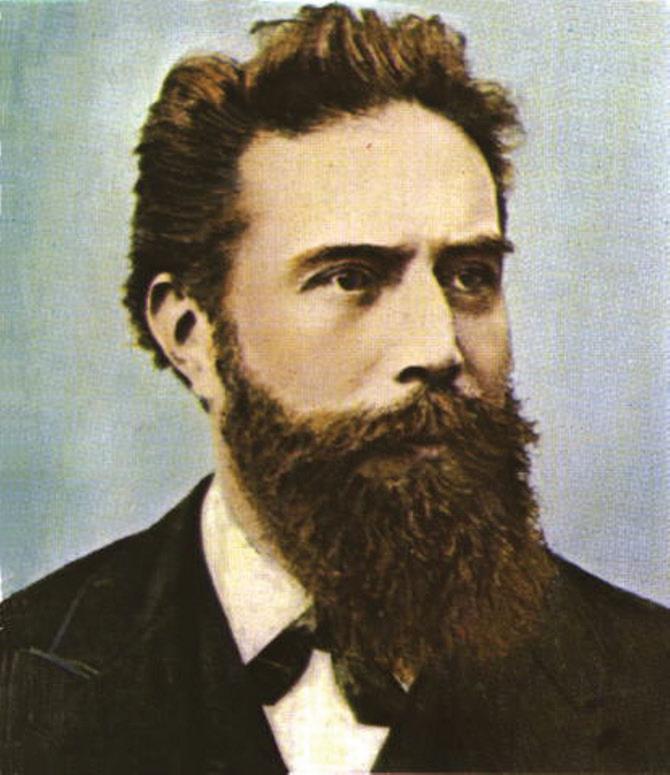
3 minute read
Who is this? SHORTSTORIES
Now here is a medical pioneer who needs no introduction, (but we’re going to give him one anyway).
This man, a household name around the world today, was born in 1845. Things were rough at first. For instance, a teacher intercepted a note he passed during class one day in high school that turned out to be a caricature of one of the teachers. It must have been quite unflattering, because it resulted in his expulsion from the school. It didn’t matter that it was drawn by someone else; he got the blame.
He found it almost impossible to be accepted to any university without a high school diploma, but he discovered that he could enter a Swiss university if he could pass an entrance exam, which he did, graduating from the University of Zurich in 1869. A series of academic positions at various universities followed, culminating in an appointment to the University of Würzburg in its physics department.
An experiment there one late Friday afternoon in November of 1895 eventually won this man the first-ever Nobel Prize in physics. The experiment was so intriguing that he spent the whole weekend in the lab, and the phenomena he discovered were so mysterious that he initially kept it all a secret, fearing it to be so unbelievable that his very sanity would be called into question if it became public knowledge.
In fact, the discovery was so puzzling that he couldn’t even give it a logical name; he had to settle for a name that conveyed the unknown: X — as in X-rays.
Yes, this is Wilhelm Roentgen (also sometimes spelled Röntgen), the father of an entirely new branch of diagnostic medicine based on his discovery of X-rays. He published his findings in late December 1895, and the world medical community quickly jumped on the sensational discovery.
Anna Ludwig, the woman who would become Roentgen’s wife (and the subject of the first X-ray image), entered the picture decades before his notable discovery. Roentgen’s father was against the romance due to Ludwig’s age (she was six years older than her suitor) and her social status (she was the daughter of a Zurich café owner). Although the elder Roentgen cut off his support for his son when they married anyway, he had apparently softened his views to the extent that when he died he left two million Reichsmarks to his son. For primarily ethical reasons (and perhaps because he could then afford to), Roentgen did not seek a patent for his discoveries, believing that the advancement should be available to all without charge. In fact, he donated all of his Nobel Prize winnings for research at the University of Würzburg. Alas, inflation following World War I left him impoverished and bankrupt. Considering the then-unknown dangers of unprotected exposure to X-rays, it’s amazing that Roentgen lived to age 77 and his wife to age 80 (they died in 1923 and 1919, respectively).
A complete list of honors, prizes, medals, honorary doctorates and honorary memberships of learned societies in Germany and around the world conferred upon Roentgen would fill the rest of this page. +
YOU SEE SOME HORRIBLE THINGS IN THE ER I have been an ER doctor for 25 years and have seen several very sad scenarios. I’ll tell you about a few of them: One was a little two year old girl who had been found on the bottom of a swimming pool. It was a typical scenario of a pool party where everyone thought that someone else was watching the kids, so no one was watching the kids. Her older sibling had been the closest to watching her, but he became distracted. He himself was a young child. She was pulled out of the pool by her father and brought in by ambulance, barely alive. We worked on her for quite a while but could not get her back. When I pronounced her dead, the trauma room was full — nurses, respiratory therapists, techs, a pharmacist, as well as both parents and several other relatives that had been at the party. The parents were devastated as were the other adults in the room. I still recall the unabashed screaming and wailing. All of us were crying. There was not a dry eye in the room.
The second memorable horrible case was a mother who piled her kids and several of their friends into a car that she decided to drive while intoxicated. They got into a horrible accident in which two of the children were killed. I don’t remember whether they were her kids or their friends. The surviving kids had injuries which varied in severity. The drunk mom had minor injuries. I talked to one of the kids who described to me how scary it was to be in that out of control car. I had to hold back the tears. Then I had to take care of the mom’s minor injuries, which was really difficult for me.
OK, here’s one more. Recently I saw a man in his early 60s who was near death with end-stage liver disease. He was jaundiced, emaciated with sunken eyes, very dry mouth, and a big swollen belly due to fluid accumulation. He was barely conscious.
His mother, who was a healthy, robust woman in her mid 80s, was quietly sitting next to his bed, stroking his cheek while tears streamed down her face. I had some time so I entered the darkened room and chatted with her a bit. I asked if she had other children. Yes, she did, she said, “but he is my baby.”









